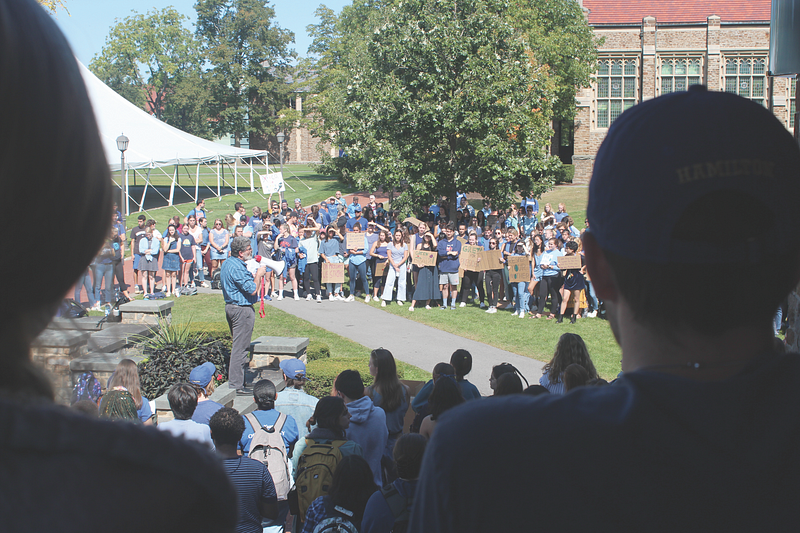
PHOTO COURTESY OF ALEXANDRA SEEWALD ’23
At 12 PM on Friday, Sept. 20, as part of an international movement, many Hamilton students participated in a campus-wide climate strike. Participants wore blue, skipped their classes as a form of protest, and attended a rally outside of Commons.
Scientists predict that unless drastic measures are taken in the near future to address pressing threats to the climate, damage to the planet will be irreversible by 2023. At Hamilton and other college campuses around the world, students showed out in protest of a perceived lack of action on climate change from local, national, and international leaders.
At the rally, painted signs (made from recycled cardboard) were passed around and strike organizers led students in chants like, “This is what democracy looks like!” and “What do we want? Climate justice! When do we want it? Now!”
The noon rally saw speeches from a variety of student leaders and performances from acapella groups like Special K, Duelly Noted, and Tumbling After.
Juasline Plasencia ’23, one of the speakers at the rally, said, “On the hottest days we cannot risk leaving our windows open nor can we afford to turn on our air conditioning. We cannot afford to relocate nor can we afford to purchase the necessary tools and supplies needed for the increase of tropical storms and hurricanes.”
Brooke Kessler ’22, one of the strike’s organizers, said that climate change “is hurting communities right now, especially those on the front line. People of color, indigenous peoples, and those living in disaster-prone areas are bearing the brunt of our unsustainable and wasteful practices.
“I want to send the message that joining in the fight against the climate crisis in not just about recycling or not using plastic straws; it is also about mobilizing into action and pursuing environmental justice.”
Strike organizers said they estimate over 100 community members attended the rally. At various points, attendees put forth their own ideas for addressing climate change. Proposed solutions varied from “better dietary options” to “better education,” in addition to “increased sustainability.” Many expressed feeling an overall anxiety about the future of the planet.
Joining the student and faculty attendees were many community members from off the Hill, including first-year students from Clinton High School. According to a teacher from the high school, the students organized their participation in the strike, skipping school and finding their own transportation up the Hill.
There were also several Clinton families at the strike. One mother, Celeste DeMore, said she attended the rally “for my children” because she wanted to “be sure that they see me try my best to fight this and to raise attention to climate change.” For their part, children were seen holding signs and writing “CLIMATE MATTERS” with chalk on the sidewalk.
For its part, the College currently has a 22-page “Climate Action Plan” that outlines its strategies for adopting more environmentally-friendly practices.
Still, Eric Stenzel ’23, a lead organizer of the strike along with Hamilton’s Climate Strike Committee, says the College’s “Climate Action Plan” does not address its relationship to the fossil fuel industry.
Stenzel said the Climate Strike Committee discovered that there are “millions of dollars invested in fossil fuels,” and added that it is not clear “exactly how much that is.”
“We don’t know which companies they’re in, and we don’t know exactly what the plan is to get them out of those companies,” he added.
Strike organizers laid out three main objectives for the rally in an all-campus email sent in the days leading up to the event. In the email, they laid out the following goals: “Show solidarity with strikes around the world, and raise urgent awareness about the issue of climate change, and especially shed light.
“Demand bold climate action at the federal and local policy level, and facilitate civic engagement with these issues.
“Support climate action initiatives on campus, such as investment and land leasing transparency, and invite our Board of Trustees to meet with Hamilton community members that concerned about fossil fuel investments at their next Hamilton meeting in two weeks.”
Additionally, Mian Osumi ’21, the Outreach Coordinator for the Climate Strike Committee, said, “[The Committee] demands divestment because it’s insane that this College invests so much in our students and what we’ve heard from the administration is that they want to make sure that we get the best financial returns on our investments […] You are not going to get good financial returns if […] it is endangering our future”
The College says it aims to cut carbon output in the coming years and become carbon-neutral by 2050. Stenzel believes the goal should be 2030.
“Hamilton is a school of less than 2000 students,” he said. “I think it’s entirely reasonable to say that we can get this to be carbon neutral in 11 years.”
Stenzel added that he believes “it is just as much a political decision to have money in fossil fuels as it is to not have it in there, because we are still funding those things that are leading to the destruction of our planet.”
On Monday, Sept. 23, from 4–6 PM in the tent on Dunham Green, College faculty members hosted an event titled Conversations on the Climate Crisis,” which served as a follow up to Friday’s strike.
Faculty participants in the discussion included professors from the Economics, Geoscience, Biology, Government, Environmental Studies, Anthropology, Literature, and History Departments. According to an all-campus email sent to the community, the event covered different strategies for climate action “in the context of the science of climate change, climate economics, the politics of climate change, climate justice, climate activism, historical perspectives on climate change, and the human dimensions of the climate crisis.”
